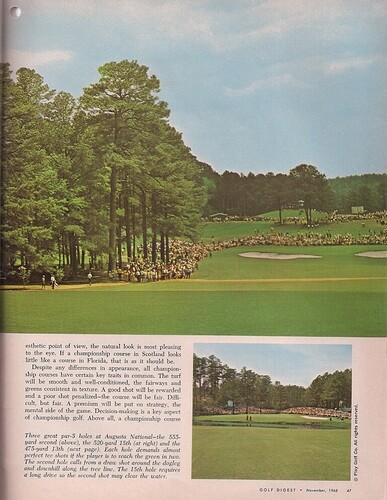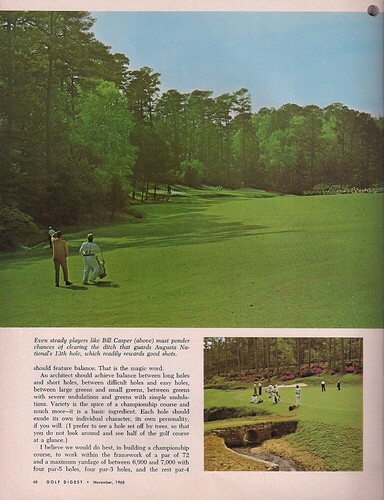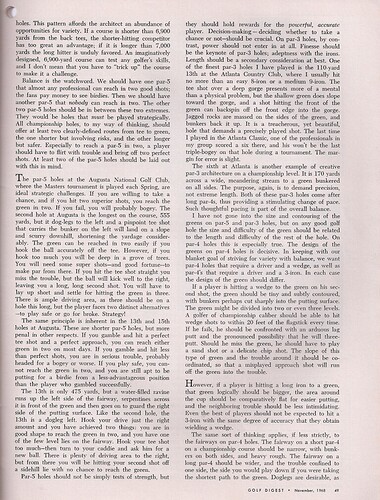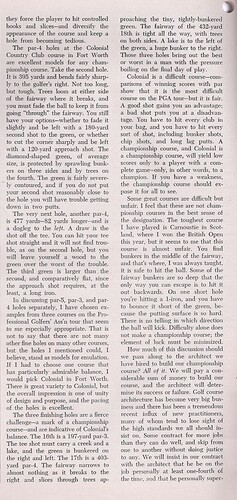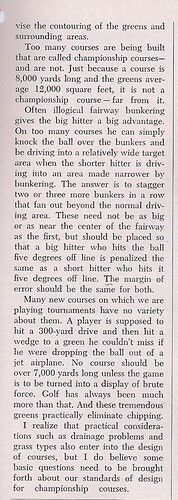A golf course could be just about anything… a place to hit from and a squirrel hole in the ground.
But in the tradition of this game… a proper test of a player should include a variety of par 3’s, par 4’s and par 5’s.
While there have been par 6’s on rare occasion, more often than not, those holes were created in an attempt to garner attention or sensationalism.
The classic par 72 layout usually has 10 par 4’s, 4 par 3’s and 4 par 5’s. Sometimes we might see 3 par 3’s and 3 par 5’s. The par 71 layouts usually have 3 par 5’s instead of 4, and the par 70 usually only 2 par 5’s. My home course has only 1 par 5 and only 3 par 3’s for it’s total of par 70.
Regardless of the par or exact number of par ___ holes, the proper course should challenge the player on their approach shots with a variety of lengths that require the player to approach with long, mid, and short irons.
The green complexes should match the required trajectory of those shots so that a well played shot will have enough of a landing strip to remain on the green regardless of general weather conditions. For instance, a predominately downwind hole that requires a mid to long iron approach should not have a green that is too shallow in depth. Greens that are fully guarded in the front, sides and back along with being very small are better suited to short par 3’s and 4’s or par 5’s where the player is given the opportunity to enter the green with a higher trajectory shot from a shorter iron.
As a golf course becomes more sophisticated in it’s design, angles into the greens major pin placements from a variety of positions from the fairway become more and more critical to the shotmaker.
A quality championship layout should be taking all these elements into consideration… but in fairness, every hole should be able to be parred with two putts from a green hit in regulation under normal to even difficult weather conditions. Obviously weather might reach beyond difficult with extremely high winds combined with rain, cold etc… making these holes play beyond their scope of design.
The par 4’s are the heart of the course. With 10 of them typically, they should require three to four mid iron approach shots (5 - 6- 7 iron), three or four long iron approach shots (2 - 3 - 4 iron), and three or four short iron approaches (8 - 9 - W) depending upon weather, conditioning, and the player’s ability.
The par 3’s should require at least one long iron approach, one or two mid iron shots and one short iron hole.
The par 5’s should offer both reachable (with a fair bit of trepidation) and non reachable (true 3 shot holes) with appropriate designed greens that take into account both trajectory and layup options.
Great courses should offer more than one option for playing a hole. Not necessarily every hole, but many of them is a signature of great courses.
So how does this relate to equipment? Quite a bit.
If the course was designed in the persimmon and balata era… it is only a great course if played with similar gear. If a modern ball and frying pan driver are used, it is no longer a great course because the requirements or determining factors for a proper championship layout are no longer in effect. While narrowing the fairways with knee high rough might keep scores looking respectable, this again is outside of the scope of the original intentions of the design and player ability requirements.
Now given that the golf ball is now going about 15% farther than it used to… a 6950 championship persimmon layout needs to be 8000 yards. But just moving the tees back does not necessarily solve the issue because many of the great courses also required a specific shot shape from the tee. The earlier balata golf balls had a much higher spin rate so curving the ball off the tee allowed access to certain pockets in a fairway.
The modern balls tend to fall down straight once they reach their apex in flight so the roll out and ground game have changed the architectural intentions often well beyond the original vision for the hole.
So essentially for a modern course to play the same… everything might need to be 15% more. That including green sizes, fairway width, length, rough height, and maybe even a faster speed on the greens as they are rolling truer than ever.
While there are a lot of things to consider here… a bigger question should be asked. Is this all really necessary?

